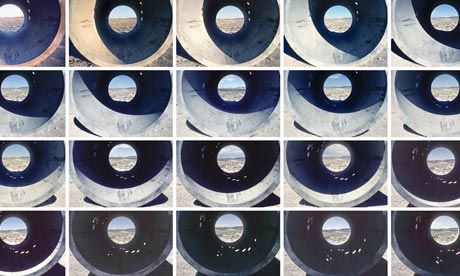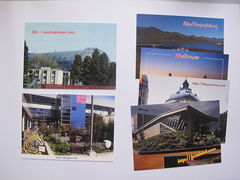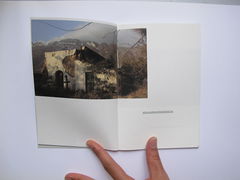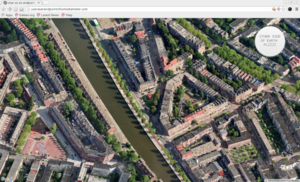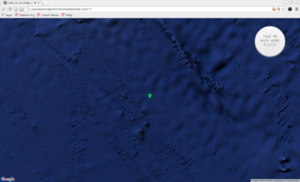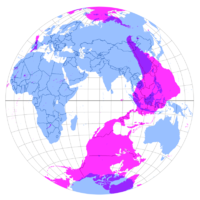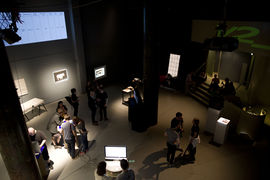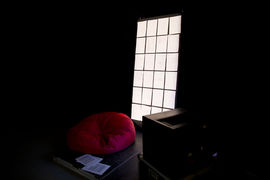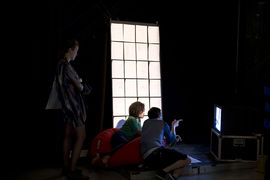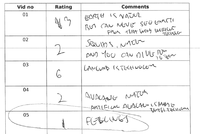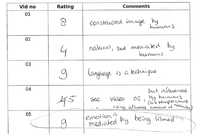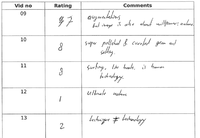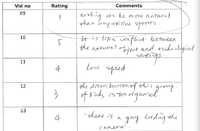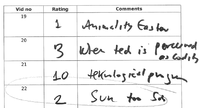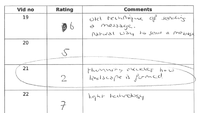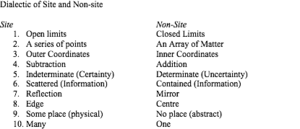User:Jules/graduationproposal: Difference between revisions
| Line 124: | Line 124: | ||
[[File:Thumb.jpg|thumbnail|right|200px|<small>In 1969, John Baldessari took a map of California and went to each place on the map where the map letters spelling ‘California’ would be located. At these sites, he spelled out the letter in any way he could and took a picture.</small>]] | [[File:Thumb.jpg|thumbnail|right|200px|<small>In 1969, John Baldessari took a map of California and went to each place on the map where the map letters spelling ‘California’ would be located. At these sites, he spelled out the letter in any way he could and took a picture.</small>]] | ||
Relating IP addresses over the Network with Earth's physical position means that I have to deal with the geographic coordinates system. This system needs knowledge of geographic cartography for decoding, since they are in a dialogue (plotted map and attributed points). It will be a necessary evil/interface for me. Geert Lovink says that ''“Richard Rogers suggests that mapping networks, especially as an intelligence task, carries with it more than just an aesthetic outcome; we are in the midst of a techno-pistemological impulse in which the form(at) of the map has a structuring effect on how we understand the organisation (structure) and dynamics (movement) of networks (2003).”'' I think that this does not apply to networks only, but to the old tradition of geographic cartography as well, although mapping digital networks has a shorter history | Relating IP addresses over the Network with Earth's physical position means that I have to deal with the geographic coordinates system. This system needs knowledge of geographic cartography for decoding, since they are in a dialogue (plotted map and attributed points). It will be a necessary evil/interface for me. Geert Lovink says that ''“Richard Rogers suggests that mapping networks, especially as an intelligence task, carries with it more than just an aesthetic outcome; we are in the midst of a techno-pistemological impulse in which the form(at) of the map has a structuring effect on how we understand the organisation (structure) and dynamics (movement) of networks (2003).”'' I think that this does not apply to networks only, but to the old tradition of geographic cartography as well, although mapping digital networks has a shorter history. They have an impression of the rest of the world that they acquired through maps. If I didn't go around the world with a mental idea of the European frontiers, within which France happens to be located, I would never be able to identify myself as a European person. Ideological content gets assigned to places through maps as they create spatial relations between groups of populations. We inhabit them as a result. As Martin Dodge puts it: ''All world maps are semiotically frontier signs, on the ground, the frontier line is not physically traceable yet maps have a performative action in the construction of territory'' | ||
All maps are untrue by essence, because they cannot represent all the things of the world (unless they were on the scale of a mile for a mile <ref>"On the exactitude in sciences" Jorge Luis Borges, 1946</ref>). Nevertheless, I think that the physical and the digital should be associated in spatial representations, since their association constitutes the social environment. I am not sure yet if I would restrain myself to the typical Mercator projection for the outcome of the project, but I will certainly need it through the process. The plotting on such model draws from the “known” and goes beyond. Doing so can provoke positive responses, | All maps are untrue by essence, because they cannot represent all the things of the world (unless they were on the scale of a mile for a mile <ref>"On the exactitude in sciences" Jorge Luis Borges, 1946</ref>). Nevertheless, I think that the physical and the digital should be associated in spatial representations, since their association constitutes the social environment. I am not sure yet if I would restrain myself to the typical Mercator projection for the outcome of the project, but I will certainly need it through the process. The plotting on such model draws from the “known” and goes beyond. Doing so can provoke positive responses<ref>''"Seeing the entire exhibition takes all of 30 seconds if you click quickly, but it will inevitably leave your perspective changed. Because even though we all know that the Internet spans the world, our browsers render it as an experience all of 13 inches wide on a laptop screen, with no image, video, or article more than a few keystrokes or clicks away. Our feedback for this exploration is wholly positive in nature—we’re constantly rewarded with content at no real cost, like children who understand the concept of money but have absolutely no concern as to how their parents make it."'' Mark Wilson<br /> http://www.fastcodesign.com/1671946/see-where-websites-live </ref> like the ones provoked by Silvio Larusso's ''Data Centre Grand Tour''<ref>https://www.youtube.com/watch?v=3YSWXHUAG4A</ref>. Also, since I am not trying to reveal any type of truth about networks behaviour, I hope that I can at least show that any story can be told when it comes to mapping. | ||
===4. About Human Ressource Management=== | ===4. About Human Ressource Management=== | ||
Revision as of 13:31, 19 November 2015
Why'd you wanna go and put stars in their eyes
Introduction
For my graduation project I want to draw constellation shapes over the world using IP addresses for points, on the basis of their geographical coordinates. Formally, this project was inspired by the Gallery Transplants made by Dennis Oppenheim in 1969. A Gallery Transplant consists in a transfer from the enclosed architectural and cultural space of the museum to an open exterior space. He applied the process to the Andrew Dickson White Museum and the Stedelijk Museum transferred respectively to the campus grounds of Cornwell University and Jersey city.
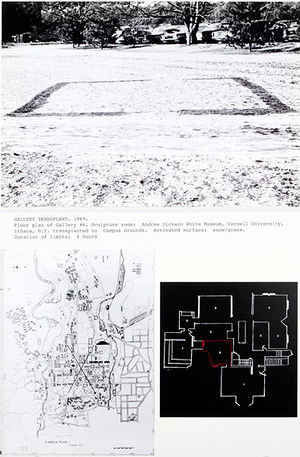
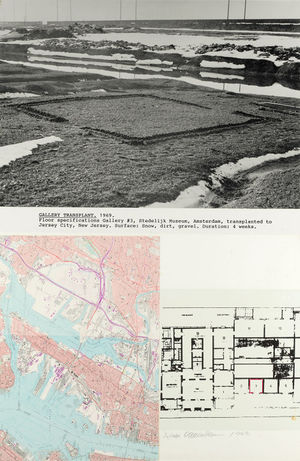
The plan of the galley's floor is drawn outside in the snow. The result is then presented with an official plan of the Gallery, a topographic map and a picture of the installation.
Robert Smithson referred to that work talking about “Dis-location” to qualify Oppenheim's process. To him Oppenheim operated in a Data transfer from a part of the world to another.[1]
This intervention will be vulnerable, because of the rapid changes over the Network and its processual nature. I will have produce documents through its realisation to testify of its conceptual existence. This would constitute the project's final outcome, since no one would be able to go on site anyway.
Thinking about the sun tunnels of Nancy Holt made me decide to go for star constellations, which is a formal analogy with computer Network topologies and a nod towards celestial navigation. [2] As an apparatus, the Sun Tunnels enables the connection between the two milieus by transferring information from one to the other.
"It’s an inversion of the sky/ground relationship-bringing the sky down to the earth."
Relation to previous practice
My previous practice is articulated around the process of mapping space and revealing invisible processes but also questioning the ways of creating such visualisations. The reflexivity on the tools is important to me because visualisations are performative and can determine our relationship to our close and distant environment. Another important thing about my work is that I never really consider my projects as formally set. They can be reactivated through different formats.
1. Browsed landscapes [3]
Browsed landscapes consists in a series of three projects like variations of the same process The different applications of the same operation can generate different highlights over the question of the place when it comes to the Internet's infrastructure outputs. The investigation was pursued over the Network with the tools I could find.
Demo on Max OS X using Google Chrome Browser
2. Userasanendpointofsomediameter [4]
With userasanenpointofsomediameter, I geolocated the user's position on Google maps and took him through a “fake tunnel” that would lead them to the antipodes of their position. Although the title suggests the World as a spherical geometrical shape, the whole process deploys itself over the flat surface of the screen. This paradox is also present within the tool used, the ubiquitous interface of Google maps is presenting to us a flattened vision of the world.
Nevertheless, within the API, I used the formula enabling to find a diameter's endpoint, in relation to any point over a circle's circumference.
var antipodes_lat = currentLatLng.lat() * -1;
var antipodes_lng = currentLatLng.lng() + 180;
3. "It reminds me of a scene in Interstellar" [5]
For the project “It reminds me if a scene in Interstellar”, I established a set of 25 videos extracts of 15 seconds each that I found on Youtube and which, to my opinion, could be ambiguous. The audio and titles were removed, to only focus on the visual content, outside its primary context. A panel of volunteers have been asked to rate the set on a scale from 1 to 10, where 1 corresponds to nature and 10 to technology. Sometimes, the volunteers explained the motivation behind the decisions they made. The average grades defined the positioning of the videos in the final montage.
The results I got were extremely variable from one person to another, underlining the difficult aspect of drawing a line between the two notions. The mental representation we have of what is natural and what is technological can conflict with the actual traces of human involvement to generate those representations.
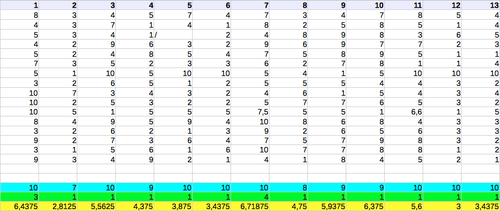
Cyan is the highest score (technology)
Green is the smallest (nature)
Yellow is the average (final position)
I asked for names and biographies because I thought that it would directly relate to the subjectivity in answers provided (a graphic designer and a nurse may not share the same view over what nature may look like, due to their education and activities)
I also specified that I wanted the sheets to be filled by hand to keep the trace of human labour involved.
Thesis intention
I would like the thesis to reflect on my process. Making an installation within a networked environment necessitates to be mediated by means for spatial representation. Since the tools for mediation plays a major part within the work, I will reflect on their implications and functioning. By doing so, they tell the story of the intentions of their creators and propagators. I think it will be also important to define what it means to locate and mediate physical locations through Digital Networks. Investigating the spatial properties of the Internet determine our relation to society and reflexively opens the reflection on what in means to inhabit space in the era of ubiquitous computer Networks. The context part is already underlining a few notions I am interested in.
Context
“Our culture is undergoing a truly drastic change in terms of our physical and psychological relationship with space and other bodies.”
-Machiko Kusahara [6]
1. Entropy
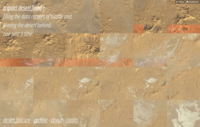
"The future is but the obsolete in reverse"
-Vladimir Nabokov [7]
[…] it's (entropy) a condition that's irreversible, it's condition that's moving towards a gradual equilibrium and it's suggested in many ways.
-Robert Smithson[8]
Following the logic described by Smithson's drawings about the Earth works, my site installation will perish, because of changes in the network. This equilibrium mentioned by Smithson is nested within the continuity experienced by users while browsing experience of the Internet, as discussed by Alexander R. Galloway.[9] Continuity is enhanced thanks to a strict set of rules which aims to ban any trace of obsolescence from the user's experience (link rot, obsolete machines, etc). The failure to maintain the work on a long time scale which is to be expected can reveal the rapid change in agencies within digital networks. It is also an act of resistance against the sensation of smooth continuity enhanced by protocols. This notion is also present in the recently unveiled A quiet desert failure[10] by Guido Segni which automates the transfer of Google's satellite images from the Sahara desert to Tumblr's data servers. The page mentions that “The whole performance will approximately take 50 years to be completed, but it is still not clear if the audience, the Google’s servers, the Tumblr archive or the Internet itself will last enough to see the end.”
Drawing a static shape over the Internet would constitute an event that will become quickly impossible to reenact and the reasons for its failure are nested within the administration of such space.
2. Capturing the invisible
"Instead of putting something on the landscape, I decided it would be interesting to transfer the land indoors, to the Non-site, which is an abstract container."
-Robert Smithson [11]
Since the installation is happening within the Internet's invisible infrastructure ( a network of digital networks), the work has to manifest within another format than its actual site. I will need to find a way to translate of the spatial dimension of the piece. The margin for variability that I like to allow within my projects is something that makes me relate a lot to Robert Smithson. In the case of Spiral Jetty (1970) for instance, Smithson considered that the work had three manifestations under the same name, and that each of them constitutes a work in its own right. Those consist in the outdoor installation at Rozel point in the Great Salt Lake (Utah)[12], the film[13] and an essay[14]. To Smithson, the sculpture was occupying a Site, while the film and the essay constituted non-sites. Language (the essay), photographic images (the film), and earth (the jetty) were considered by Smithson as materials of equal values. This approach is certainly informed by the aforementioned notions of entropy but also due to the intentions behind the site intervention. The work is processual, on an environmental scale , and in a remote location. The idea of the piece has to manifest in a shape that is appropriate to the context in which it is being communicated about. The different formats used can contrast with each other in terms of their capacity to endure time and space. Similarly, a digital network intervention can re-manifest itself within different strategies to communicate about its intentions. Moreover, my work cannot be experienced at all, so the only proof that the configuration I will show exist will be visible within the documents.
3. Inhabiting maps
Relating IP addresses over the Network with Earth's physical position means that I have to deal with the geographic coordinates system. This system needs knowledge of geographic cartography for decoding, since they are in a dialogue (plotted map and attributed points). It will be a necessary evil/interface for me. Geert Lovink says that “Richard Rogers suggests that mapping networks, especially as an intelligence task, carries with it more than just an aesthetic outcome; we are in the midst of a techno-pistemological impulse in which the form(at) of the map has a structuring effect on how we understand the organisation (structure) and dynamics (movement) of networks (2003).” I think that this does not apply to networks only, but to the old tradition of geographic cartography as well, although mapping digital networks has a shorter history. They have an impression of the rest of the world that they acquired through maps. If I didn't go around the world with a mental idea of the European frontiers, within which France happens to be located, I would never be able to identify myself as a European person. Ideological content gets assigned to places through maps as they create spatial relations between groups of populations. We inhabit them as a result. As Martin Dodge puts it: All world maps are semiotically frontier signs, on the ground, the frontier line is not physically traceable yet maps have a performative action in the construction of territory
All maps are untrue by essence, because they cannot represent all the things of the world (unless they were on the scale of a mile for a mile [15]). Nevertheless, I think that the physical and the digital should be associated in spatial representations, since their association constitutes the social environment. I am not sure yet if I would restrain myself to the typical Mercator projection for the outcome of the project, but I will certainly need it through the process. The plotting on such model draws from the “known” and goes beyond. Doing so can provoke positive responses[16] like the ones provoked by Silvio Larusso's Data Centre Grand Tour[17]. Also, since I am not trying to reveal any type of truth about networks behaviour, I hope that I can at least show that any story can be told when it comes to mapping.
4. About Human Ressource Management
"Territory is not given, but constituted, and this constitution is likewise the organization of the individuals in it."
Baudrillard
One of the many reasons of my interest for the Environmental movement of the 60s is that it was very much concerned with the way in which we inhabit society and construct our perception of space. In a text published in Artforum in April 1977, Nancy Holt reflects on the process of making the Sun Tunnels. In 1974 she bought a piece of land in the Great Basin Desert, Utah, where she decided to build her piece. She described that the site installation and the documentation of the process, required the help of “2 engineers, 1 astrophysicist, 1 astronomer, 1 surveyor and his assistant, 1 road grader, 2 dump truck operators, 1 carpenter, 3 ditch diggers, 1 concrete mixing truck operator, 1 concrete foreman, 10 concrete pipe company workers, 2 core-drillers, 4 truck drivers, 1 crane operator, 1 rigger, 2 cameramen, 2 soundmen, 1 helicopter pilot, and 4 photography lab workers.” Then, she concluded with the following sentence: “In making the arrangements and contracting out the work, I became more extended into the world than I’ve ever been before.” This made me think that drawing with IP addresses over the Earth is not just my own personal enterprise. It puts me in relation with a lot of places, corporations and bodies involved with the regulation of the Internet as the space it is. By creating such type of work, one acts from their direct environment and draws new configurations for encounters between people. With Networks, these relations evolve, through what telecommunication enables for one individual to reach. Awareness or not because people get more ignorant of their implication within phenomenons they are not taking active part of.
“I will call an apparatus, literally anything that has in some way the capacity to capture, orient, determine, intercept, model, control, or secure the gestures, behaviors, opinions, or discourses of living beings."
-Giorgio Agamben
As a consequence, mapping space and delineating shapes over Earth provokes a re-agency of human activity on a particular set of conditions and over a huge scale. To me, nothing is more tangible than understanding that something is physically somewhere in relation to us.
Practical steps
At the moment, I am getting more familiar with the tools. I am using a MongoDB version of the MaxMind GeoIP legacy database. I have exported some json files compiling all the relevant data on Latitude and Longitude criteria. I will start using the Google Maps API for a first draft but I would like to be able to cross with other types of maps.
After Christmas, I'll need to make more complex requests , such as precise geometrical shapes to get actual stars constellations. Then I will be able to work on prototypes showing the information. I am very open on the shape, as I will have to see that in time with the generated content (video, images or text).
Alongside this, I want to retrieve information on my collaborators. Who are the people behind Maxmind? How does the labour work and where are the people located. I have already tried to get a bit of information when I wrote a text on GeoIP databases, but perhaps getting in touch or envisioning a way to let them know about my work would be nice. I like to exchange with others when I work and having these types of logs is valuable to me.
Regarding the documentation of my references and process, I will stick to the tools I have developed over the last year. Firstly, I have adapted the interface of a very simple cms which I can update it from my computer over my server thanks to Git. It functions as a notebook which helps me keep a trace of what I have been reading. It is quite flexible and I try to add pads next to my notes in case I ever want to cross references.
→ http://pzi.here-you-are.com/notebook/ .
I have prepared the same system to have a set of images I can refer to
→ http://pzi.here-you-are.com/imgdir/
Sometimes, when investigating a specific topic, I also write a text as it helps me assimilate information that I have been gathering and and associate facts together. This practice often goes alongside making practical sketching experiments such as the following ones :
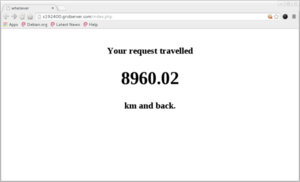
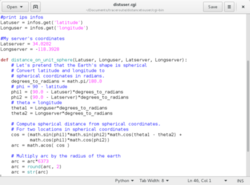
https://pzwiki.wdka.nl/mediadesign/User:Jules/opticsofdatatransmission
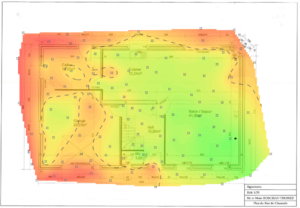
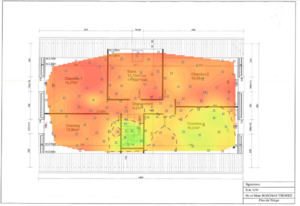
https://pzwiki.wdka.nl/mediadesign/User:Jules/wifiheatmap
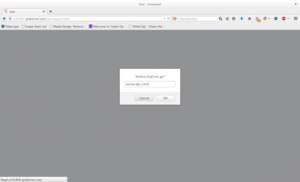
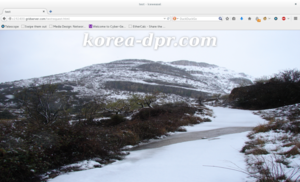
http://pzwiki.wdka.nl/mediadesign/User:Jules/geoipdatabases
References
1. Artworks
- Sun Tunnels – Nancy Holt, 1976 (human management over land, information transfer)
- Would you like to participate in an Artistic experience – Ricardo Basbaum, 1994-ongoing (human management over land)
- How and where to draw the circle? – Ian Wilson, 1968 (politics of spatial delineation)
- When Faith Moves Mountains – Francis Alys, 2002 (Human management)
- Gallery Transplants – Dennis Oppenheim, 1968 (data transfer, entropy)
- A quiet desert failure, Guido Segni – 2013-ongoing (Digital Entropy)
- Spiral Jetty – Robert Smithson, 1972 (variability)
- Spiral Jetty in Minecraft – Jan Robert Leegte, 2013 (contextual reactivation)
- Vertical Earth kilometer – Walter de Maria, 1977 (The title is the Non-site)
- Socle du monde – Piero Manzoni, 1961 (map imprinted in the brain)
- The california Map Project – John Baldessari, 1973 (inhabiting the map)
- Map – Aram Bartholl, 2010-? (inhabiting the map)
- Data centre Grand Tour – Silvio Larusso, 2012 (mapping creates a new reality - quote)
2. Bibliography
- Imagining Internet Infrastructures: Spatial Metaphors and Scientific Inscription (Understanding Cyberspace Cartographies: A Critical Analysis of Internet Infrastructure Mapping, chap 4 ), Martin Dodge, 2008
- Entropy and the new monuments, Robert Smithson, 1966
- What is an apparatus? Georgio Agamben, 2009
- Theses on distributed aesthetics or what a Network isn't, Anna Munster & Geert Lovink, 2005
- Tout a failli, vive le communisme! Tiqqun, 2009 (not sure if it has been translated)
- Protocols or how control exists after decentralization, Alexander R. Galloway, 2004
- Anti Oedipe, Deleuze and Guattari, 1972
- Simulacra and simulation, Baudrillard, 1981
- Steps to an ecology of the mind, 1972 Gregory Bateson
- Postscript on the societies of control, Gilles Deleuze, 1992
- On exactitude in science, Jorge Luis Borges, 1946
- The Internet Revolution: From Dot-com Capitalism to Cybernetic Communism, Richard Barbrook and Andy Cameron, 1995-1999
- E flux journal, the Internet does not exist, 2015
- Atlas of cyberspace, Martin Dodge, 2001
- From weak ties to organized Networks, Ideas, Reports, Critiques,Inc, 2009
3. Links
https://artforum.com/inprint/issue=197704&id=35992
https://en.wikipedia.org/wiki/Satellite_map_images_with_missing_or_unclear_data
http://www.fastcodesign.com/1671946/see-where-websites-live
http://www.theguardian.com/artanddesign/2015/feb/04/google-data-farm-john-gerrard-internet-art
4. Extensive listing
For actual set of references, or just things that trigger my interest, please see:
http://pzi.here-you-are.com/notebook/
The notebook contains etherpads on which anyone can add thoughts or references they feel like doing such
http://pzi.here-you-are.com/imgdir/
- ↑ (1)Lisa Bear et Willoughby Sharp, "Discussions with Heizer, Oppenheim, Smithson (1970)", In : Robert Smithson : The Collected Writings, Berkeley, Los Angeles, London, University of California Press, 1996, p. 244.
- ↑ https://pzwiki.wdka.nl/mediadesign/User:Jules/linkingdots
- ↑ http://pzwiki.wdka.nl/mediadesign/User:Jules/browsedlandscapes
- ↑ http://userasanendpointofsomediameter.com/
- ↑ http://pzwiki.wdka.nl/mediadesign/User:Jules/remindsmeofinterstellar
- ↑ “Presence, Absence, and Knowledge in Telerobotic Art,” in The Robot in the Garden, 2000
- ↑ "Lance", 1952
- ↑ "Entropy made visible", 1973
- ↑ "Protocols or how control exists after decentralization", 2004, p 68
“All technology is new technology. Everything else must be eliminated. Dead media are those media that have fallen out of use. They include everything from dead hardware (Commodore 64, Apple II) to dead computer languages (Fortran, Cobol) to dead media formats (Sony Betamax, 8-track cassette). Dead media means discontinuity. Dead media do not function within contemporary network flows; therefore, they have no place.” - ↑ http://desert.fail/ure/
- ↑ (Kasther and Wallis, 1998: 31)
- ↑ http://www.robertsmithson.com/earthworks/spiral_jetty.htm
- ↑ https://www.youtube.com/watch?v=vCfm95GyZt4
- ↑ The Spiral Jetty, 1970, published in Robert Smithson: The Collected Writings, edited by Nancy Holt, New York University Press, pp. 109-113
- ↑ "On the exactitude in sciences" Jorge Luis Borges, 1946
- ↑ "Seeing the entire exhibition takes all of 30 seconds if you click quickly, but it will inevitably leave your perspective changed. Because even though we all know that the Internet spans the world, our browsers render it as an experience all of 13 inches wide on a laptop screen, with no image, video, or article more than a few keystrokes or clicks away. Our feedback for this exploration is wholly positive in nature—we’re constantly rewarded with content at no real cost, like children who understand the concept of money but have absolutely no concern as to how their parents make it." Mark Wilson
http://www.fastcodesign.com/1671946/see-where-websites-live - ↑ https://www.youtube.com/watch?v=3YSWXHUAG4A

